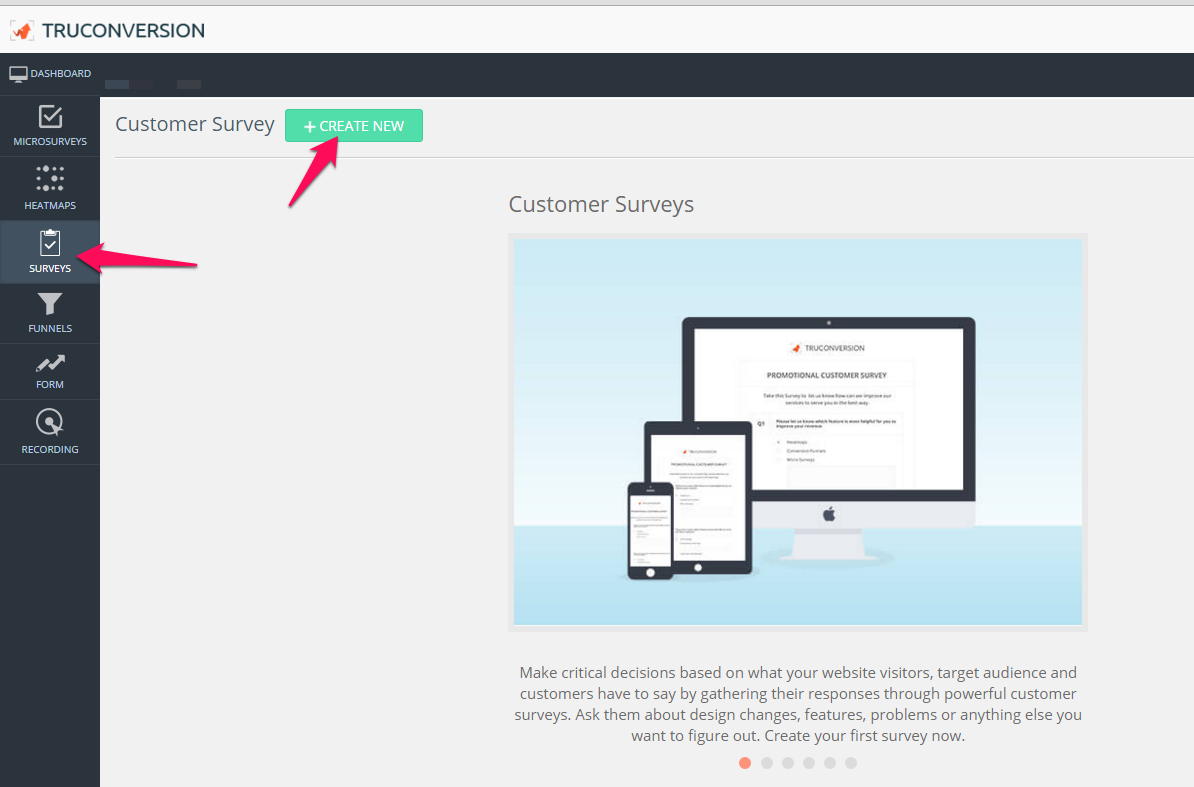There are many different ways to improve your website’s conversions.
Whether it’s tweaking your funnel, improving your checkout process or bringing in better traffic, you need to start somewhere.
So why not start with your bread and butter – your customers?
Read on to learn how to improve conversions with Customer Feedback Surveys.
- What Is a Customer Survey?
- Why Do You Need A Survey?
- Set The Right Goals For Your Customer Surveys
- Survey Users Based On Site Interactions
- Apply A Customer Survey Based On Your Visitors’ Data
- Do You Need Customer Personas?
- How Are Personas Built?
- What Elements You Should Consider When Building Personas
- Collect Data And Feelings From Your Visitors
- Tips On Creating A Customer Survey And The Impact It Can Have On Your Conversion Rate
- The Tools You Can Use
- Mistakes to Avoid in Making A Survey
- Recommended Reading: Articles And Guides
Contents
What Is a Customer Survey?
Before we begin, it’s important to clear up a few concepts. I found more than one definition for Customer Surveys, so here are two of them, short and concise:
“From measuring customer satisfaction to capturing your Net Promoter® Score, online surveys help you understand what you’re doing well—and what you need to improve.” (Source: SurveyMonkey)
And the second one:
“Process of discovering whether or not a company’s customers are happy or satisfied with the products or services received from the company. May be conducted face to face, over the phone, via email or internet, or on handwritten forms.” (Source: BusinessDictionary)
If their needs are hidden, how could you possibly discover them? How could you discover their expectations for new or proposed products?
Let’s say that you plan to launch a Steak House. You advertise the hell out of it, your social media campaigns are brilliant, presenting the team, the chef, you promise irreproachable service, the food looks incredibly good and you already created buzz in your local area.
Everyone is waiting for the restaurant to open its doors. Everyone is anxious and expecting a delicious dinner. You succeed doing all of the above.
You have 100 tables occupied. No matter what you will do and how the chef will lead his team, you won’t satisfy every client.
Why? Because everyone was expecting to have a different experience. Not necessarily one better than the other, Just different.
You will have very happy customers and they will most likely come back at your steak house pretty soon and they will recommend your restaurant.
You will have satisfied customers that will probably come back and unsatisfied customers that won’t come back.
So after a while, you decide to create a customer survey to find out why the unsatisfied customers feel that way and why the satisfied customers are the way they are.
Some people prefer eating a salty and peppery steak while others are more into something well done.
Client satisfaction survey will reveal what the trends are between your clients and help you discover other things you could improve. Also, it will put you and your business in the position of thinking outside the box, because customer feedback is probably the best feedback you can get. Feedback surveys allow you to interact with the people who are using your product. Learn from them and you’ll improve your products and conversions.
Pre-emptive surveys allow you to overcome complaints by taking action and speaking with your customers before their order – „good evening sir, how would you like your steak?” – Problem solved.
You can do that online as well, no matter what you are selling – you just need to put some thought behind your survey questions.
Why Do You Need A Feedback Survey?
In terms of efficiency and cost, feedback surveys are very useful way to find out more about customers or potential customers.
One example of a business that used customer feedback surveys to improve its conversions is Teespring.
The company allows you to buy custom-made tshirts, but also crowdfund them. If enough people purchase your tshirt, it goes into production and you make money off of it.
Since this concept is not easy to understand at first, the company ran a few surveys to see if customers knew about this side of the business. They managed to find a few key elements that users were afraid of – including being charged upfront for t-shirts that were being crowdfunded.
After the found these results, they implemented an A/B test on the Buy Now Button.

The new button had additional text at the bottom, which alleviated fears that customers would have to pay upfront for t-shirts that were still being crowd funded.
The result? A 12.7% increase in conversions, all coming from information from customer feedback surveys.
You want to develop a strong relationship with your customers and prospects? Give them the opportunity to interact with your product and brand. They will provide the best feedback so you can improve their experience. There is social peer pressure to answer questions. People tend to want to talk about themselves and are glad to open up and share their opinions. Even if sometimes that means adjusting to a social reality they’re living in.
Surveys are absolutely necessary tools for you, as a marketer who thinks in terms of sales and wants to create a great user experience. Surveys will help you:
- Learn more about your customers’ preferences
- Provide better products and services your customers are interested in or need
- Find out what is not satisfactory
- Improve your communication with your customers
- Learn about competing brands and businesses, in relationship to yours
Give your customers and subscribers the opportunity to make themselves heard, to say what their preferences are or why they are not satisfied with your services. Most importantly, listen and act accordingly. Questionnaires are a good opportunity to find out what they really want.
Set the Right Goals for Your Customer Feedback Surveys
Before sending the survey through e-mail or have it set up on your website, you have to plan out your goals.
In order for them to make sense, they need to be SMART. That stands for:
- Specific
- Measurable
- Achievable
- Realistic
- Timed
We can’t just say: “I want to have more sales” or “I want to have 100% more sales”. Those aren’t SMART goals. Below you’ll find a good example of how you should organize your goals:
You need to first know your business and your market to be able to set goals. Without this data, you’ll be hunting blind, without a clear target in site.
Analyze the problems that your product has. Think about how you can solve them by sending a basic questionnaire:
- You can improve your products’ and services’ quality
- You can improve your communication with prospects/customers
These are the steps to establish a solid relationship with them over time and to keep them as (loyal) customers. Keep these premises in mind, send questionnaires to your list of customers, and based on their responses, enhance the quality of what you offer.
More than anything: listen to your customers. Don’t just aim to fix something, because a few of them said it was broken or not working properly. Send additional surveys and try to get to the root fo the problem. What are they REALLY trying to solve by using your product or service? Only by understanding your visitors will you truly provide a remarkable experience that will transform them into customers.
How to create Customer Survey Questions?
Customer Survey questions can be designed based on the types of services you provide. Want to know how your customers perceive a transport service, auto service or how they are treated by your customer service staff? Find out their opinion by sending them questionnaires via email or simply ask them online, on your website.
In the next 2 case studies we’ll take a look at how companies and websites are able to use product feedback survey to answer meaningful questions, to drive conversions and sales.
The first case study is for PhotoShelter, a web app that lets photographers store, manage and sell their pictures online.

Surveying their users with online surveys, PhotoShelter realized their free app had limited functionality and wasn’t persuading people to upgrade to the full app. On the other hand, making people pay for the full app trial made sure they’re interested and are already spending money on it.
The results? Along with a few more changes coming from on-site survey answers, PhotoShelters sales doubled in one year.
The second case study is for Learn Visual Studio .NET, a website dedicated to helping people learn this programming language.
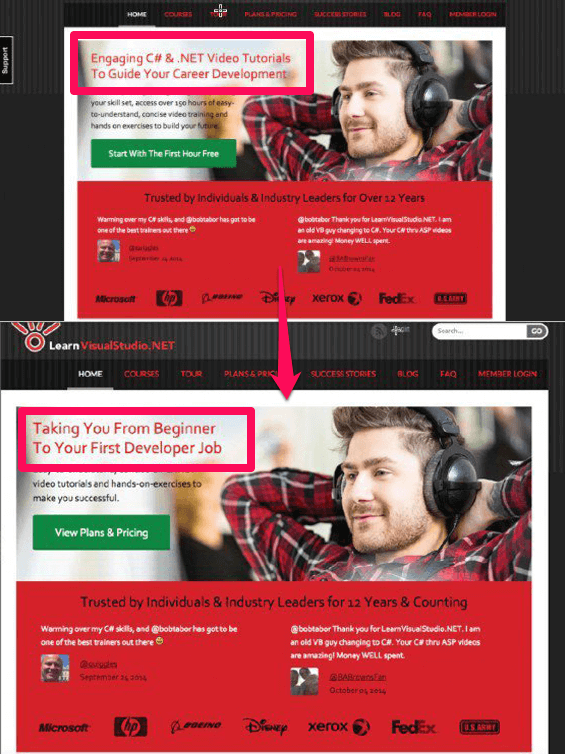
Surveying their users, they wanted to know what their skill levels were. Since most of them were beginners (about 2/3 of them) and their focus wasn’t just learning more, but also finding their first job, they made changes to the landing page.
They turned the inward-focused “Engaging C# & .NET Video Tutorials To Guide Your Career Development” to the user-centric “Taking You From Beginner To Your First Developer Job”.
It’s another case where surveying users gives you amazing insights into what they’re looking for and how you can tailor your images and messaging to match their desires.
Segment your database according to your customers and the services they are using. For each type of service offered you can have one different satisfaction questionnaire. If for example, a total of 20 people called one day for one of your services, they will quickly receive, a follow-up questionnaire regarding their satisfaction with that specific interaction.
Use a tool like TruConversion to easily create and deploy micro-surveys, based on what pages users visit on your website. This not only brings you specific responses from people who have actively engaged with specific site sections, but also helps your users provide feedback in bite-sized increments.
Create Online Customer Surveys Based On Your Visitors’ Data
Let’s say that you run a Google Analytics report and that 60% of the Organic traffic is coming from USA, 20% of the traffic is coming from United Kingdom, 10% Germany and the rest of 10% from other countries.
Checking out the conversion rates based on the Geo-Location you will notice the following:
- U.S.A. with the biggest slice of pie based on the traffic metrics has a conversion rate of 5%;
- United Kingdom has an insignificant conversion rate;
- Germany with only 10% of the traffic also gets a 5% conversion rate.
You will get to this conclusion: Germany sends a lot LESS traffic than U.S.A., but gets the same 5% conversion rate.
Are you thinking what I’m thinking? Of course. You want to know why.
You want to know why Germany converts way better than U.S.A. You also want to understand why U.S.A. is having such a poor conversion rate while having huge potential. If Google Analytics doesn’t provide the answers, it’s time to go to the customer feedback surveys.
You don’t want to ask the same survey questions to all your visitors. You should try and segment them.
You want to ask the visitors from Germany what they find appealing on your website and what made them make the decision of buying the product or service you sell.
You want to ask visitors from U.S.A. what keeps them from buying your products, what difficulties they encounter in surfing your store and how they would make improvements to your store – it could be anything, from design to content and functionality.
Clearly there are different cultural backgrounds between the to. Your challenge will be in trying to figure out what you can do to alleviate these differences and boost your overall conversion rate (starting with the U.S.A.).
You can’t ask very direct questions. You have to be creative and offer your visitors a small reward in exchange for their feedback – a discount code, a free download, etc.
Do You Need Buyer Personas to create a Customer Survey?
Of course you do. Every new online business needs to build customer personas early on. You have to know where you’re headed, who your potential customers are and what they find interesting.

What are Buyer Personas? Although it may seem that a persona is the same as a user, there are a few key differences.
Buyer Personas are the basic types of users that might come across your website. Although they are fictional, personas are based on real user behavior. They represent the needs, values and goals of multiple users groups.
Used as a substitute for real users, personas are tools that help designers take crucial decisions in the process of product creation, development and functionalities of the product – in our case, webpages and entire websites.
Understanding the needs of users is vital in any project. Personas will help identify users’ communication needs in an efficient and productive way. The designers, developers and marketers won’t risk falling the trap of building functionalities that only they might find useful. As the design progresses, it can be evaluated based on the personas that were initially created.
The basic features of personas are:
- Represents categories of users, not specific individuals
- They express the major users’ needs and expectations
- It gives a clear picture of users’ expectations and indicates how they will use your product
- It helps the process of discovery and evaluation for product functionality
An example of a Buyer Persona can be seen below:
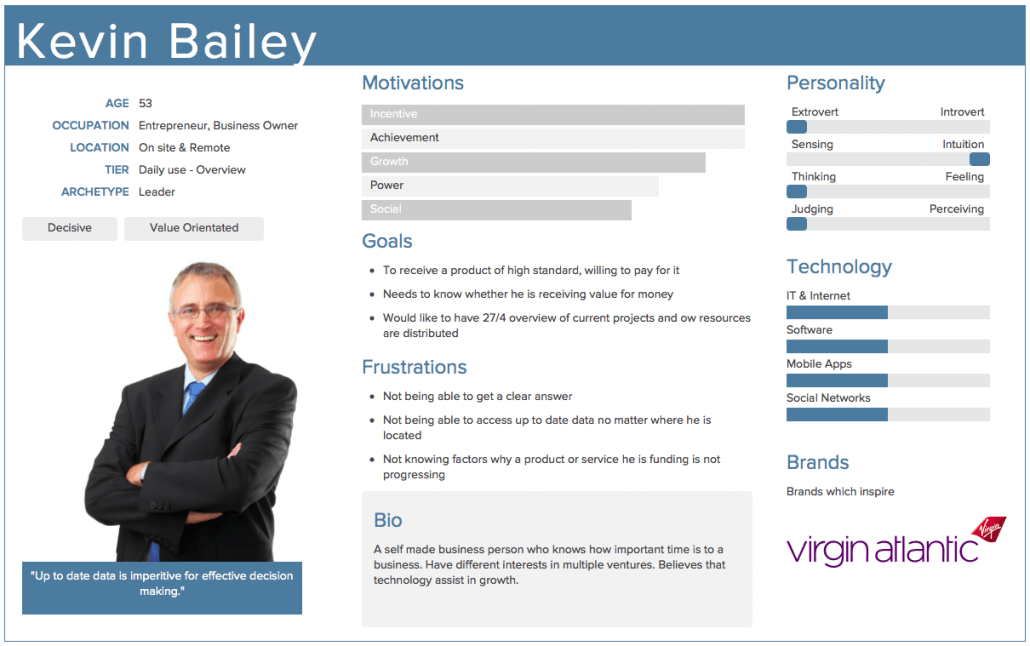
Briteplan is an enterprise SaaS cloud application. Building it from the bottom means knowing who it’s for, first. Three User Personas were identified – The Entrepreneur/Business Owner, The IT Project Manager, The Accountant.
They all have different motivations, goals and frustrations. They all look and think differently. You have to be able to find common ground; otherwise the SaaS application couldn’t have been built. Some common traits were identified among all the User Personas.
Once you know what drives a person, what their inspiring brands are, you are more likely to create products that they can relate to.
Since we’re looking at a real-life person, we can’t ignore the things that drive him, the things that frustrate him and what his goals are. When we understand those, we’re one step closer to getting a conversion.
How to Create Buyer Personas?
Buyer Personas are built at the beginning of the project simply because they can help in the process of developing the product specifications and even indicate undiscovered growth opportunities uncovered by the competition.
Classic personas are built by talking with users and taking notes. Whether a new or existing project is to be improved, it’s necessary to find and catalog the different types of the users that might use your web application, project, ecommerce website, etc.
As interviews start, common traits between users star to appear, generating fragments of personas.
Often, the lack of time or resources does not allow interviewing potential users, and thus many are resorting to the use of other resources. Brainstorming and collaborating with the departments of sales, marketing and customer support, insights tend to crystallize in personas. This could also prove to be useful, but don’t get too stuck within the walls of your organization.
You don’t want to make assumptions about your users. You want to use data you’ve gathered in the field to create scales, graphs and built conversion models that you’ll test and improve as time goes by.
One aspect must be underlined here- two or maximum three buyer Personas are enough. It’s better to broadly outline, to express and to work to meet the needs of the majority, than trying to satisfy each one of them in particular! The personal purpose is to focus on the needs of the most representative user groups and less on the users on the edges.
What Elements You Should Consider When Building Buyer Personas?
The complexity and detail of a buyer persona are determined based on the project. There may be instances in which a few basic features are enough, but in general, they include:
- Name
- The group affiliation (photographer, marketer, etc.)
- Function and responsibilities
- Demographics
- Education Level
- Marital status
- Financial situation
- Physical and social environment in which they live and act
- Objectives and needs they want to satisfy when using the product or service
- An image to represent the group

Buyer Personas are an effective way to refine the market research and the know-how in a less abstract and easier way to work with.
But what about a complementary approach to the basic Customer Survey? Sure, try collecting feelings and thoughts.
Collect Data and Feelings from Your Visitors through Feedback Surveys
Using Google Analytics we can analyze URL data at the website level, but using visual analytics applications, we can identify problems faster, with better accuracy. Heatmaps and video recordings help you analyze visitor behavior on the site.
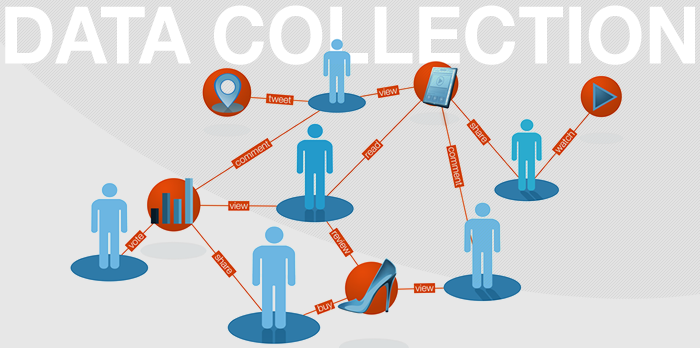
TruConversion integrates these tools and it’s very quick to get started. Integrate the code on your website, choose the tool you want to run and you’re done.
By analyzing this information, you will find out if the elements that you find important are accessed by customers, or even if the content is read or at least scanned. You can use the Scrollmaps variation for Heat maps to see where site visitors move their mouse and how they tap on screen to navigate on a mobile device.
A good example of deploying Heatmaps to increase conversions is the app for couples Pair. Too many people seemed to click on the Blog, Help, Jobs links in the top left of the landing page.
With Heat mapping they discovered what the points of interest were and so they removed the elements that had an impact on users clicking on the app store buttons.
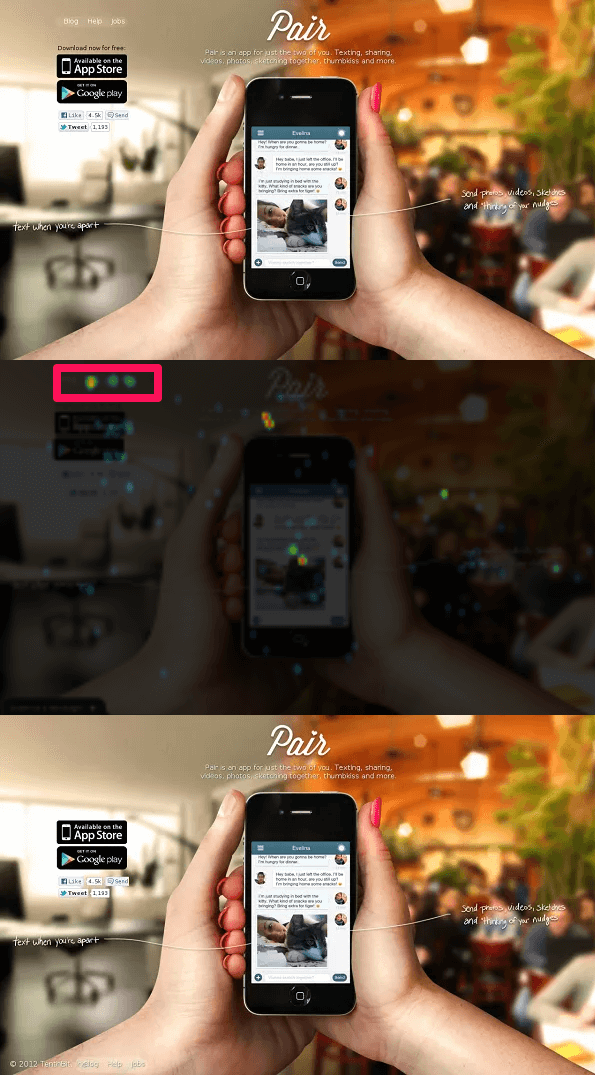
Removing distractions and increasing focus on the buttons that lead to the app stores really made the difference. They also moved the distracting elements at the top. So they’re still on the page, but they don’t interfere with someone downloading the app.
The result? A 25% increase in conversions. Impressed yet?
Voice of the customer is the most important when it comes to conversion rate optimization. Solving problems or complaints raised by them has a positive effect on sales. Listen carefully to what your visitors are saying and focus on fixing their problems, not your website specifically. That means you should care about them more than as a potential customer. Since they’re a source of great insight, you should use them wisely.
How can you identify what problems your clients have while browsing your site? In addition to the above recommendations, you can use applications to “interview” your visitors. You can ask for responses to different questions, you can define the information that you want from your users through a simple click.
With this type of analysis you should be careful how you’re targeting the visitor, because depending on the source of traffic, demographic data and how they are interacting with your site, different information will be obtained. In most cases it is recommended to do tests on new traffic.
We’re using Micro Surveys to find out what our blog readers want, in terms of premium content. Not only that, but we’re testing title ideas and formats. That way, we’ll know the title that will be the most attractive and whether readers want an ebook, a guide, a course, etc.
It’s all done using Micro Surveys from TruConversion. A small window pops up when readers scroll near the bottom of an article. It shows a specific question related to the article they’re reading. This helps us create the premium content that our users will be most interested in. We’re pre-testing ideas and formats using Customer Feedback Surveys.
The opinions of those who come on your site for the first time are more important than those who already know you, or those who are already your customers. For the simple fact that they already had the confidence to buy from you and managed to overcome any problems or inconveniences. New users, however, tend to be a lot more honest – and unforgiving – when it comes to website design, checkout process time, etc.
Today’s technology allows triggering of surveys that pop up when the user wants to leave the site. Here is when we can ask him about why he chose to do so without buying something. This is called an Exit Intent Survey.
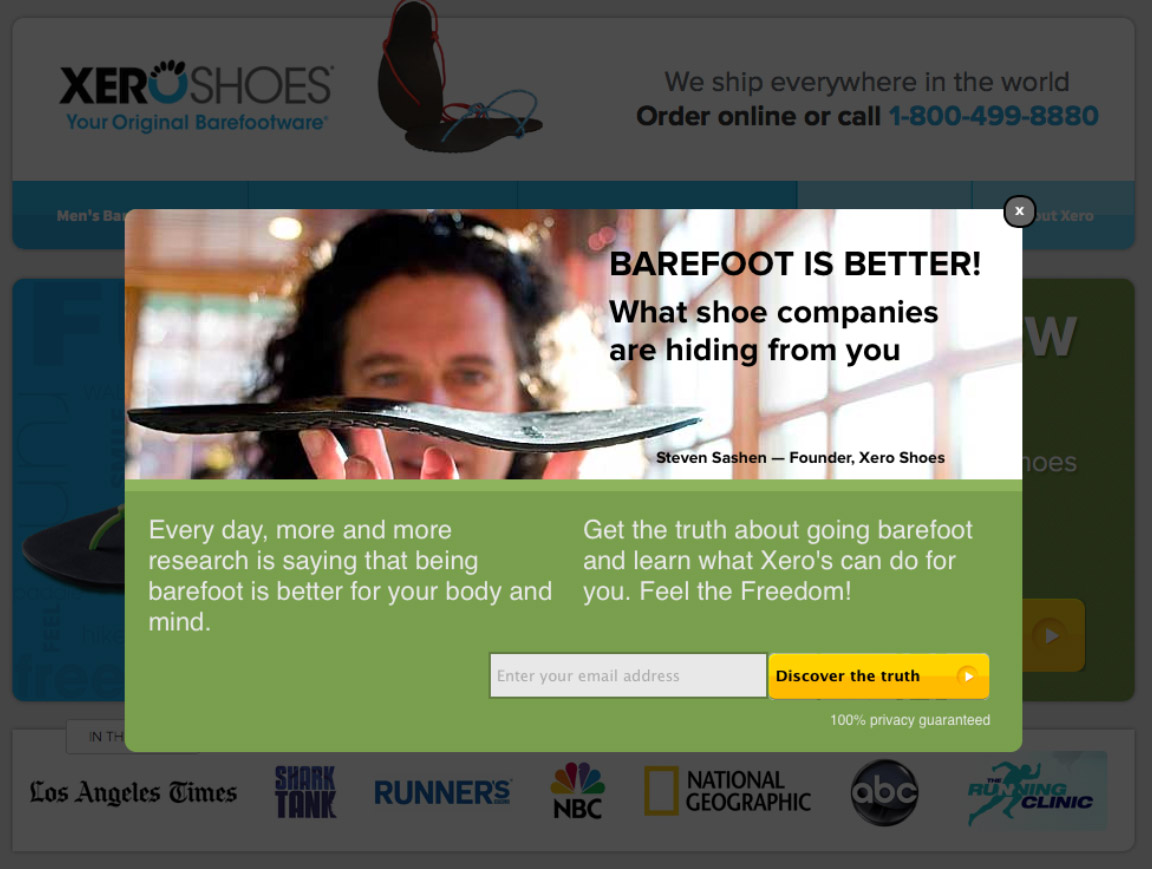
Steven Sashen founded XeroShoes, together with Lena Phoenix, after he suffered injuries from running and started investigating barefootware.
Since the concept and technology were new at the time, he decided to engage with potential customers who were just about to leave the website. The Exit Popup showed up when users moved their mouse near the address bar in their browser, signaling they wanted to leave the website. The popup provided an offer for a free report on the benefits of barefootware.
The results? Only 2.5% of abandoning users wanted the report. But out of those, a staggering 28.4% went on to make a purchase on the website. All thanks to Exit Popups.
Tips on Creating a Customer Survey and the Impact It Can Have On Your Conversion Rate
Constant measuring of customer satisfaction will help you analyze whether your efforts have a positive or negative impact on your customers. With this information, you can set up a strategy based on the needs of your consumers that will eventually increase their satisfaction with using your product or service.
With the help of consumer satisfaction index you can build a lasting relationship with your clients. You can approach them with personalized interactions, giving them a unique experience on your website.
The consumer satisfaction index is an indicator that measures the satisfaction of consumers. Since it uses the 1-10 scale, it’s easy to tally up the results and understand how well you’re doing.
People have more confidence in the recommendation of a friend than in the words of a marketer.
Friendship actions build Advocacy, which sparks Conversations, that lead to Recommendations that turn into Sales, which are usually higher in profit and lower in acquisition costs.
Once the customer is satisfied and engaged in social media activities the possibility that they recommend your website to others increases dramatically.
The index of consumer satisfaction can be improved through various aspects of your website:
Use Deals to Increase Customer Satisfaction
There are several types of deals, depending on which page your visitor is. Build your offers according to your Conversion Funnel.
For example, you can have deals on the homepage, product page, the cart page or post-purchase offers.
On the product page, you can influence your consumers to accelerate their buying process, acting on instinct to not lose the opportunity. Here are some examples: “There are only 3 rooms available!”, “Free Shipping for orders over $100!”, “Buy now and you have a 15% discount.”

daFlores is an online retailer specialize in sending flowers and flower arrangements. Their research showed that people weren’t sure when the flowers would arrive and they didn’t know the website offered same-day delivery. Since most people in their client satisfaction survey responses sent flowers last-minute, they needed to be alerted to the fact that ordering within a certain timeframe would guarantee a delivery that day.
They emphasized this fact with a few text changes and adding a big clock, alerting people about the same-day delivery option.
The results? A 27% uplift in orders from this tiny change that was put in place, thanks to answers gathered from user surveys and research.
Provide surprises in the cart page for your customers. Come up with surprises that will make them act more quickly – you can add gifts, giving them the chance of picking one.
Post-order offers are essential for increasing your consumer satisfaction index. For example, you can provide vouchers, discounts for future purchases and you can make suggestions to recommend your website, if they were satisfied with the experience they had.
You don’t have to provide material goods. Send guides, eBooks and other free digital materials that contain valuable information relevant to your consumers.
Use Fast Delivery to Increase Customer Satisfaction
A fast and efficient delivery system will improve the consumer satisfaction index. Consumers want safe and fast product delivery. Nobody likes to wait. That’s exactly why they are ordering online – they want to avoid the stress of walking through multiple crowded stores and waiting in line to pay.
It is also necessary to deliver products without any defects. Turn the delivering process into a unique one by implementing and using custom packaging. Try to minimize delivery costs more. Consumers will be thrilled with a delivery system that’s safe and fast!
How Payment Options can be used to Increase Customer Satisfaction
It is recommended to have as many payment options available on your website so that consumers choose the most convenient method.
Take the time to research what payment options are preferred in each country. That way, you’ll be able to use consumer data (even data gathered from surveys) to provide a unique, personalized shopping experience.
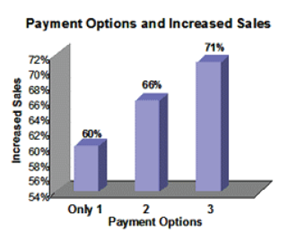
A study conducted by CyberSource polled 147 leading online retailers. While it isn’t shocking to find that repeat and loyal customers increase sales overall, one finding was particularly interesting.
Adding a few more payment options (from 1 to 3) can lead to an increase in conversion of over 18%.
How Return Policy can be used to Increase Customer Satisfaction
Inform your customers that it’s ok to return the product in case they are not happy with it.
Make sure you ask them the reasons for product returns. Unlike regular visitors, consumers are willing to spend 3 minutes to answer a questionnaire about the products they bought and services they need.
The feedback survey is a powerful tool to learn the strengths and weaknesses of your website. Find out why your visitors quickly leave your site. Find out why the conversion rate suddenly decreases or increases. If you discover your consumer problems, you can come up with strategies that will increase the conversion rate and therefore, sales.
For example, you can create a survey to measure consumer satisfaction index, asking these customer experience survey questions:
- Will you return to our website? If yes – why?
- What do you think about our website?
- Any suggestions for us?
- Would you recommend the website to your friends? If not – why not?
The answers obtained through this kind of survey will give you an overview about consumer satisfaction on your website. In conclusion, the index of consumer satisfaction is an important indicator for your conversion rate optimization process, offering valuable insights into what customers expect to find on your website.
Used properly, a satisfaction index can increase the number of returning visitors to your website and you can easily establish a lasting relationship with your customers. This will increase the number of loyal customers; you’ll end up with lower customer acquisition costs and more conversions.
How to create a Customer Survey using TruConversion?
TruConversion offers you to create customer surveys with unlimited questions and unlimited answers. You can use Skip Logic to jump to another question, depending on the user’s answers. This allows you to create entire sequences for each scenario.
The Customer Surveys are fully responsive, so you can display them on computers, tablets and mobile devices, without any issues.
Micro Surveys are a trimmed down version of the previous tool. They allow for customizable design (text, colors, logo, etc.) and the can be triggered by events or exit intent.
Use the questions library if you’re stuck and view the final answers using the simple and intuitive reporting feature.
Creating a survey within TruConversion is easier than you’d think. You can think of TruConversion as a package of tools, one of it being the online survey tool. Let’s take a look at how to create a Customer Survey with TruConversion.
Click on the Surveys tab on the left side menu and then click on the green
+Create New button.
A popup appears asking you whether you want to create a new survey from scratch or select from popular survey templates.
If you click on “See All Templates” at the bottom of the popup, you’ll be taken to a new screen, where you can preview the templates – on desktop and mobile – and also change the survey language.
Since the templates are pre-built, you don’t have to think about how to create survey questions or what best customer survey question are. It’s all done for you! The templates provide sample customer satisfaction survey questions and they act as customer survey examples for you to learn from and apply right away.
If you click on the Preview button you’ll get a change to look at your survey, before it’s launched on your website. You can review any changes you need to make, before making it live.
Since TruConversion’s Customer Surveys are responsive, they look great on any device. Having great feedback tools for websites at your disposal means you’ll always know what your customers think about your products and services. Having on-site surveys deployed translates to users responding to your questions, while they’re interacting with the website – they’re in the act of learning about you and you get to ask targeted questions that can help you increase conversions.
With this preview you get to see the questions, the answers, the overall layout and the final send button.
Users are asked to participate with a pre-survey question, so you know the people answering aren’t bots or there to waste your time. That means that deploying a Customer Survey will yield great user insights.
Once you select the template, you’ll be taken to the survey editing screen. Here you can customize your survey introduction, add questions, reorder them, add or remove answers. And the best part? All of the changes are updated in real time and the preview window lets you know what it will look like.
Asking users to fill in your survey is easy once you set up your targeting and messaging. You can have it show up only on certain pages or devices. You can customize the accept and the decline text. And all of it is in plain sight with the preview window, in the lower right side of the screen.
If you want to show the feedback survey instantly, you can do that. There are also advanced triggers, like when a user scrolls to a certain percent down the page, has spent a certain amount of time on the page or is intending to leave the website (Exit Intent for Customer Surveys – TruConversion can do that!)
The Design step is probably my favorite, since it really shows how customizable and user-friendly the Customer Surveys are. Once again, any changes you make in the left side are automatically shown in the preview pane to your right. With this TruConversion feature, you’re always in control of your survey appearance.
The final step allows you to review your survey once more and set an activation trigger. You can have the survey start right away or schedule it at a certain time. Once you’re satisfied with your choices, feel free to click the “Save & Review” button in the lower right side.
The final screen is a last review of your options and you only need to click one button to finally launch your TruConversion Customer Survey.
Once you’ve done that, you’ll see your survey stats – when it was launched, how many views it got and how many answers you’ve received. You can activate or deactivate it, archive it or duplicate it if you feel like it.
When you click the “View Responses” button, you’ll be able to see a detailed report about the responses you’ve gotten.
Now that you know how easy and effective it is to create a Customer Survey in TruConversion, it’s time to move on to the last major chapter – figuring out what mistakes you shouldn’t make when creating your surveys.
What Mistakes to Avoid in Making a Customer Feedback Survey
- A first mistake you can make as a marketer is to ignore the importance of a good questionnaire.Maybe one of your clients had a problem with your service and he was not able to express it. That client might not return to your website. Furthermore, without any knowledge of this, he might tell his friends about the bad experience he had. And since loyal customers drive an additional 80% of business, everyone is crucial to your sales. And they’re worth fighting for.Therefore, it’s good to be one step ahead of the customer and give him the opportunity to evaluate your product, even if the feedback is undesirable to you.
- When designing a customer feedback survey, think of the time your customers have.A survey shouldn’t last more than 2-3 minutes. In general, the indicated questions are the ones that can be answered with Yes and No, but add the possibility to insert comments.
Do not make the mistake of writing down just the simple questions that will not clear your mind about customer satisfaction. - Keep both eyes focused on the way your questions are formulated.Questions should be clear and to the point. You can test these with a sample group of users or within your company. Go with people who know your product/service the least. That way you’ll get a balanced view on the questions and the way they are formatted.You don’t want to risk getting bad data back just because you didn’t deploy the language your visitors actually use and are accustomed to.
- If your customer interactions are frequent, avoid sending frequently assessment questionnaires.Try to find the best time for them, making the evaluation process on a longer period of time. Don’t ask for all the info at once. Split your feedback surveys into smaller ones.There is no golden rule for great survey questions.There is no best time or ideal frequency for a questionnaire to be sent. It all depends on the goals that you establish and the focus on your services, with the final goal of keeping your customers happy.
Recommended Reading: Articles And Guides
Articles
7 Killer Survey Questions To Send To Your Customers To Kickstart Your Next Conversion Rate Program
How to Boost Conversions with Voice of Customer Research
Could Customer Research Be the Key to Unlocking a Higher Conversion Rate for Your Business?
How Online Surveys Helped Teespring Increase Conversion by 12.7%
Guides
The Definitive Guide To Conversion Rate Optimization
How to Write a Customer Survey
The Ultimate Guide To Writing A Customer Feedback Questionnaire




